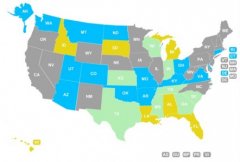Iowa electoral votes
Recent voter ID concerns have centered on legal challenges that affect the 2014 mid-term elections in November. But how does the voter ID landscape look for the next presidential election?
 Under the Constitution’s federal election process, voters will choose Senators and Representatives next month in various statewide elections, with the entire House and one-third of the Senate up for re-election. The winners will be the candidates with the most votes in each state. (The passage of the 17th Amendment took away the original power in the Constitution for state legislatures to choose Senators.)
Under the Constitution’s federal election process, voters will choose Senators and Representatives next month in various statewide elections, with the entire House and one-third of the Senate up for re-election. The winners will be the candidates with the most votes in each state. (The passage of the 17th Amendment took away the original power in the Constitution for state legislatures to choose Senators.)
All that seems very simple, and the recent actions by the Supreme Court have clarified, at least for the November elections, voter ID challenges in Texas and Wisconsin. The strict voter ID law in Texas will be in force for the November 2014 election; the strict voter ID law in Wisconsin won’t.
A strict law requires voters to present a photo ID or another acceptable identification at the polls, or they must vote on a provisional ballot and take additional steps after Election Day to present identification.
A non-strict law allows some voters without acceptable identification at the polls to cast a ballot that will be counted, without further action on their part. Various states have provisions for checking on the identities of these voters in different ways.
So what happens to the voter ID controversy after this November? Aside from the challenges in Texas and Wisconsin, the Arkansas supreme court has struck down that state’s strict voter ID law. Pennsylvania also won’t appeal a state judge’s decision that disallowed its 2012 strict ID law.
The Pennsylvania case is interesting because the voter ID clash in the Keystone state was a significant factor during the 2012 election, when Pennsylvania was seen, by some people, as a swing state in the Presidential election. Various legal measures kept the strict voter ID law from going into effect for the race between Barack Obama and Mitt Romney.
The Supreme Court could very well rule on cases in the several states that have appeals, but a quick look at key swing states in the upcoming 2016 election shows where the controversy over access to the polls will come into play.
The key to recent Presidential elections has been swing states, and the party that controls the majority of votes in these states usually wins the election. A broad list of swing states starts with about 15 contested states, and the list gets smaller as Election Day nears.
You might also like









